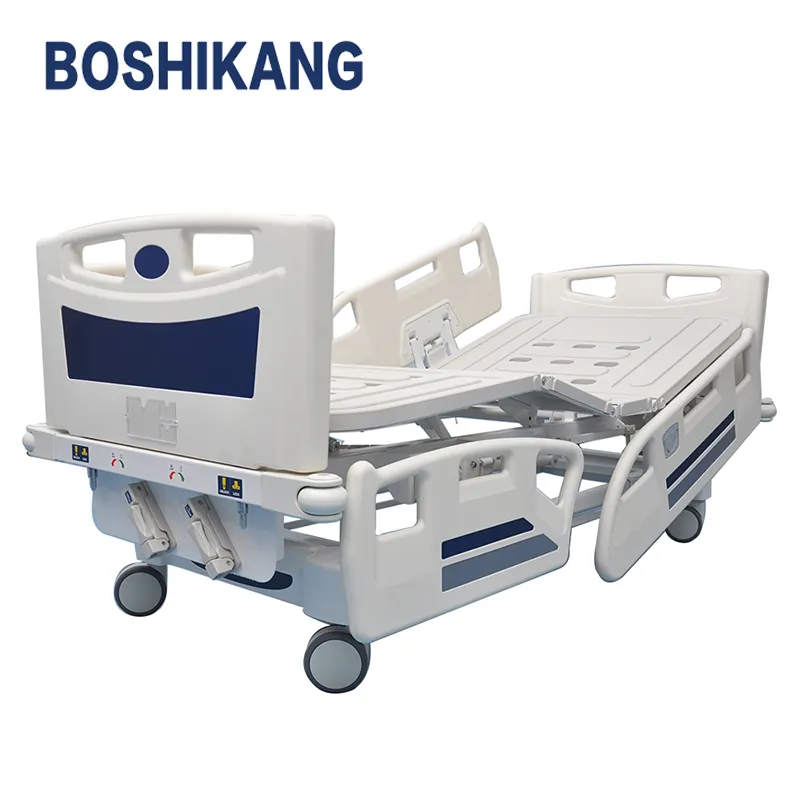Motorized Adjustability for Patient Safety
Height Adjustment Capabilities
Adjustable bed heights powered by motors really make a difference when it comes to meeting different patient requirements and what caregivers need in hospitals and clinics. When staff can easily raise or lower beds as needed, they get the positioning just right for each situation. This simple feature cuts down on back problems for nurses who spend hours moving patients around. Studies have shown that these adjustable beds actually cut injury rates among healthcare workers by about 30% when compared to fixed height beds. The height adjustment also makes transferring patients between beds and wheelchairs much smoother, which means safer handling for everyone involved. Patients generally feel more comfortable too. These kinds of adjustments aren't just convenient they're practically necessary in places like ICU units where getting the bed at exactly the right level can mean better outcomes for critically ill patients.
Trendelenburg Positioning
Trendelenburg positioning plays a key role in managing blood flow for patients in acute care settings, particularly those lying in ICU beds. When the body is tilted back at about 15 degrees, it helps push more blood back toward the heart, which makes all the difference for people with low blood pressure and might even save lives during critical moments. This matters most for seriously ill patients whose blood pressure tends to swing around unpredictably. But there's a catch here folks need to remember proper technique because getting this wrong can cause problems down the road. That's why hospitals invest time training their staff properly on these adjustments. Modern ICU beds come equipped with Trendelenburg features so nurses and doctors can quickly adjust positions based on what the patient needs right then, making sure everyone stays safe while receiving quality care.
Fall Prevention Systems
Keeping patients safe from falls is really important in ICU environments. Modern hospital beds now come with adjustable side rails that can be set up differently depending on what each patient needs.医护人员可以根据患者的不同需求调整床栏的高度和配置。这些侧栏的灵活性大大降低了医院内跌倒事件的发生率。研究表明,当正确使用这些侧栏时,确实能有效减少跌倒风险,既保护了病人安全,又让他们保持一定的自主性。很多医疗机构已经开始意识到这一点,通过定制化设置侧栏来促进病人的活动能力。这样做不仅让病人更容易自己照顾自己,同时也保证了必要的防护措施到位。有些医院甚至发现这种调整还能帮助护士更快地完成日常护理工作。
Bed exit alarms represent an important part of preventing falls within healthcare settings. The technology works by sounding alerts when patients try to get out of bed, which cuts down on fall risks substantially. Research shows that these real time monitoring systems actually help nurses respond faster, and this leads to better results for patients overall. When hospitals combine these exit alarms with proper staff training programs, they really boost how effective the whole system becomes. Patients then get help sooner and there are fewer incidents where someone ends up falling. Looking at the bigger picture, such advancements in fall prevention tech speak volumes about how seriously medical facilities take keeping ICU patients safe from harm.

Pressure Injury Prevention
Advanced Mattress Technologies
The latest tech in ICU bed mattresses plays a big role in stopping pressure sores before they start. Modern designs work by spreading out weight distribution across different parts of the body, which cuts down on those painful pressure points that lead to bedsores, sometimes called decubitus ulcers. For folks stuck in bed most of the time or unable to move around much, this even weight spreading makes all the difference. People with spinal injuries or after major surgery often spend weeks in the same spot, making them especially vulnerable to skin breakdown from constant pressure on certain areas.
Scientific Evidence: Studies, including those published in medical journals, have demonstrated the efficacy of pressure-relieving mattresses in reducing the incidence of pressure ulcers among high-risk patients. This evidence underscores the importance of investing in technologically advanced mattresses as part of a comprehensive care strategy to improve patient outcomes.
Enhanced Features: In addition to pressure redistribution, advanced mattresses often incorporate features like air circulation and temperature control. These enhancements not only improve patient comfort but also promote overall skin health by maintaining an optimal environment that prevents moisture and heat buildup, which can lead to skin breakdown.
Modern ICU beds equipped with these advanced technologies offer a robust solution for pressure injury prevention, ensuring patients receive top-tier care that addresses their unique needs and promotes healing.
Infection Control Features
Antimicrobial Surface Coatings
ICU beds with antimicrobial surface coatings are making a real difference when it comes to stopping infections from spreading in critical care areas. The special coatings help keep things cleaner by slowing down the growth of microbes right on those frequently touched surfaces. Research shows that when surfaces get treated with these antimicrobial materials, infection rates tend to drop quite a bit, which helps hospital staff fight infections better overall. For hospitals struggling with lots of HAIs, adding these coatings to equipment makes all the difference. We've seen some facilities cut their infection problems almost in half after implementing this kind of technology across their wards.
The significance of antimicrobial coatings becomes clear when looking at how healthcare facilities deal with hospital-acquired infections on a daily basis. Many hospitals now make these coatings a top priority because they help cut down on germs in spaces where patients are most vulnerable. These special treatments go hand in hand with standard practices like good waste disposal and thorough cleaning routines. Take ICU beds for instance they offer comfort while actually working behind the scenes to stop dangerous microbes from spreading. Some facilities have even started tracking infection rates before and after implementing these coatings, showing measurable improvements in patient outcomes. As hospitals continue their quest for safer care environments, antimicrobial surfaces will likely remain a key component in preventing disease transmission across different clinical settings.
Emergency Response Capabilities
CPR Release Mechanisms
The CPR release mechanism built into ICU beds plays a really important role during emergency resuscitation because it lets staff quickly adjust the bed to a completely flat position. This kind of feature makes all the difference when trying to save someone's life, especially those moments where every second counts. Research indicates that hospitals with good CPR training programs for their staff see better outcomes overall. When medical teams know exactly how these mechanisms work, patients stand a much better chance. Keeping these systems well maintained isn't just routine housekeeping either. A simple check now and then can prevent equipment failures at precisely the wrong moment, which could cost precious minutes in an already tense situation.
Stability and Braking Systems
The stability and braking mechanisms built into ICU beds really matter for keeping patients safe during sudden medical crises. When doctors or nurses need to perform emergency treatments, these systems stop the bed from moving around unexpectedly, something absolutely necessary for proper patient handling. Hospital staff constantly talk about how important it is to have beds that won't shift during delicate procedures like intubation or administering IV medications. Nobody wants complications because a bed starts rolling while someone's trying to save a life. That's why regular checks and maintenance on these safety features are so important. Most hospitals schedule routine inspections to make sure everything works properly, just in case an emergency hits at any moment.
Integrated Monitoring Systems
Modern ICU beds come equipped with integrated monitoring systems that track patient vitals in real time while making healthcare delivery much more efficient overall. The constant stream of data these systems generate helps nurses spot subtle changes in a patient's condition before things get really bad, something that could mean the difference between life and death in some cases. When different medical devices talk to each other through this network, doctors respond faster when emergencies hit. Take blood pressure monitors and heart rate sensors working together seamlessly for instance. Patients generally end up getting better treatment sooner because of all this connectivity, though there are still challenges with implementing such technology across different hospital departments.
Adding integrated monitoring systems to ICU beds makes things run smoother in hospital settings. When doctors and nurses have access to real time data from these systems, they catch problems faster and work better together across different departments. Patients tend to recover quicker too because the medical staff gets all their information in one place instead of running around for updates. The real value comes during those chaotic moments when multiple patients need attention at once. These systems let healthcare workers focus on what matters most without getting bogged down by paperwork or missing vital signs. That's why hospitals investing in such technology often see better results for critically ill patients over time.
FAQs about Motorized Adjustability and ICU Bed Features
What is the importance of motorized height adjustment in ICU beds?
Motorized height adjustment is crucial for accommodating patients with different needs and caregivers’ preferences, reducing the risk of back strain and aiding in patient transfer and ambulation.
How does Trendelenburg positioning benefit ICU patients?
This positioning aids in enhancing venous return to the heart to stabilize blood pressure, particularly important for hypotensive or critically ill patients.
What role do side rail designs play in fall prevention?
Configurable side rails can be adjusted for height and configuration, reducing fall incidence and promoting patient independence and safety.
How do antimicrobial coatings contribute to infection control?
These coatings reduce microbial growth on bed surfaces, lowering the incidence of hospital-acquired infections and enhancing patient safety.
Why are integrated monitoring systems vital in ICU beds?
They enable real-time tracking of patient vital signs, improving communication and response time during critical situations.


